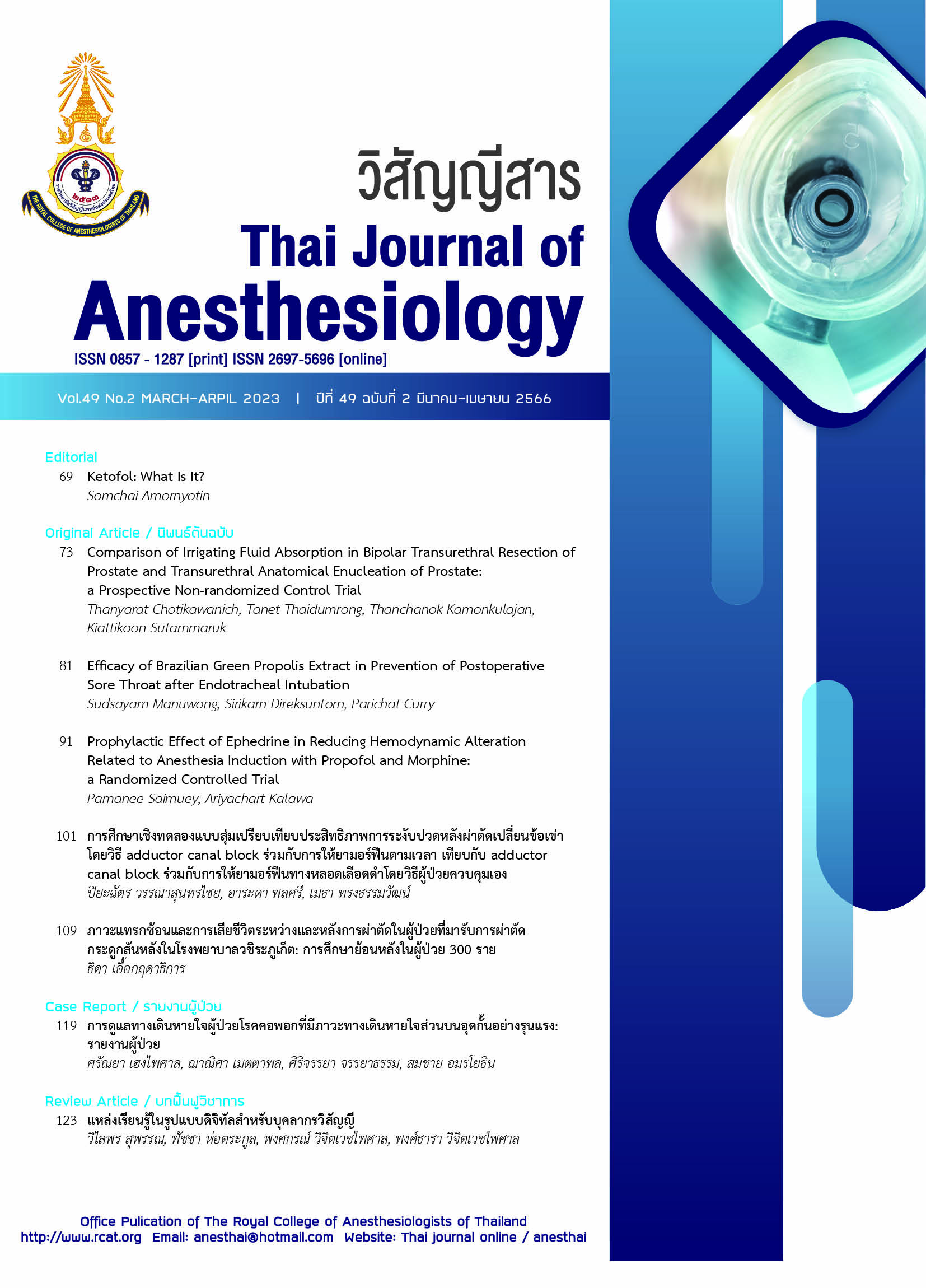Efficacy of Brazilian Green Propolis Extract in Prevention of Postoperative Sore Throat after Endotracheal Intubation
Main Article Content
Abstract
Background: Postoperative sore throat has been a common complication and a patient’s undesirable outcome after general anesthesia (GA). The incidence varies from 30% to 70% while the standard treatment has not been established. Objective: To study the effect of propolis spray for prevention of postoperative sore throat after GA with endotracheal tube (ETT). Methods: A prospective, randomized, double-blind, controlled study, we compared the incidence of sore throat and hoarseness of voice after GA with ETT. One hundred and thirty-two ASA class I and II patients undergoing elective surgery under GA with ETT were randomly assigned into two group: propolis and control groups. Group P (propolis) patients received propolis spray on the vocal cords and vallecula during ETT intubation and group C (control) received normal saline spray. After the surgery, postoperative sore throat and severity of hoarseness of voice were recorded by a blinded anesthesiologist at 0-2 h, 6 h, 24 h and 48 h after surgery. Result: The overall incidences of postoperative sore throat and hoarseness of voice were similar in both groups. Forty-one patients (67.2%) in the propolis group and forty patients (61.5%) in the control group had postoperative sore throat. Fifty patients (82.0%) in the propolis group had hoarseness of voice, compared to forty-nine patients (75.4%) in the control group. The VAS scores for postoperative sore throat were comparable in both groups. Conclusion: Applying propolis spray directly on the vocal cords and vallecula during ETT intubation does not prevent postoperative sore throat after GA with ETT.
Article Details

This work is licensed under a Creative Commons Attribution-NonCommercial-NoDerivatives 4.0 International License.
References
Tanaka Y, Nakayama T, Nishimori M, Tsujimura Y, Kawaguchi M, Sato Y. Lidocaine for preventing postoperative sore throat. Cochrane Database Syst Rev. 2015;7:CD004081.
Sumathi PA, Shenoy T, Ambareesha M, Krishna HM. Controlled comparison between betamethasone gel and lidocaine jelly applied over tracheal tube to reduce postoperative sore throat, cough, and hoarseness of voice. Br J Anaesth. 2008;100:215-8.
Christensen AM, Willemoes-Larson H, Lundby L, Jakobsen KB. Postoperative throat complaints after tracheal intubation. Br J Anaesth. 1994;73:786-7.
Mandoe H, Nikolajsen L, Lintrup U, Jepson D, Molgaard J. Sore throat after endotracheal intubation. Anesth Analg. 1992;74:897-900.
McHardy FE, Chung F. Postoperative sore throat: cause, prevention and treatment. Anaesthesia. 1999;54:444-53.
Macario A, Weinger M, Carney S, Kim A. Which clinical anaesthesia outcomes are important to avoid? The perspective of patients. Anesth Analg. 1999;89:652-8.
Lehmann M, Monte K, Barach P, Kindler CH. Postoperative patient complaints: a prospective interview study of 12,276 patients. J Clin Anesth. 2010;22:13-21.
Kalil DM, Silvestro LS, Austin PN. Novel preoperative pharmacologic methods of preventing postoperative sore throat due to tracheal intubation. AANA J. 2014;82:188-97.
Castaldo S, Capasso F. Propolis, an old remedy used in modern medicine. Fitoterapia. 2002;73(Suppl1):S1-6.
Burdock GA. Review of the biological properties and toxicity of bee propolis (propolis). Food Chem Toxicol. 1998;36:347-63.
Khalil ML. Biological activity of bee propolis in health and disease. Asian Pac J Cancer Prev. 2006;7:22-31.
Marcucci MC, Ferreres F, García-Viguera C, et al. Phenolic compounds from Brazilian propolis with pharmacological activities. J Ethnopharmacol. 2001;74:105-12.
Banskota AH, Tezuka Y, Kadota S. Recent progress in pharmacological research of propolis. Phytother Res. 2001;15:561-71.
Mirzoeva OK, Calder PC. The effect of propolis and its components on eicosanoid production during the inflammatory response. Prostaglandins Leukot Essent Fatty Acids. 1996;55:441-9.
de Moura SAL, Negri G, Salatino A, et al. Aqueous extract of Brazilian green propolis: primary components, evaluation of inflammation and wound healing by using subcutaneous implanted sponges. Evid Based Complement Alternat Med. 2011;2011:748283.
McLennan SV, Bonner J, Milne S, et al. The anti-inflammatory agent propolis improves wound healing in a rodent model of experimental
diabetes. Wound Repair Regen. 2008;16:706-13.
Borrelli F, Maffia P, Pinto L, et al. Phytochemical compounds involved in the anti-inflammatory effect of propolis extract. Fitoterapia. 2002;
(Suppl1):S53-63.
Paulino N, Teixeira C, Martins R, et al. Evaluation of the analgesic and anti-inflammatory effects of a Brazilian green propolis. Planta Med. 2006;72:899-906.
Paulino N, Dantas AP, Bankova V, et al. Bulgarian propolis induces analgesic and anti-inflammatory effects in mice and inhibits in vitro contraction of airway smooth muscle. J Pharmacol Sci. 2003;93:307-13.
Samet N, Laurent C, Susarla SM, Samet-Rubinsteen N. The effect of bee propolis on recurrent aphthous stomatitis: a pilot study. Clin Oral Investig. 2007;11:143-7.
Propolis: MedlinePlus supplements [Internet]. medlineplus.gov. Available from: https://medlineplus.gov/druginfo/natural/390.html
Donnelly WA, Grossman AA, Grem FM. Local sequelae of endotracheal anesthesia as observed by examination of one hundred patients. Anesthesiology. 1948;9:490-7.
Scuderi PE. Postoperative sore throat: more answers than questions. Anesth Analg. 2010;111:831-2.
Burdock GA. Review of the biological properties and toxicity of bee propolis (propolis). Food Chem Toxicol. 1998;36:347-63.
Cirasino L, Pisati A, Fasani F. Contact dermatitis from propolis. Contact Dermatitis. 1987;16:110-1.
Hay KD, Greig DE. Propolis allergy: a cause of oral mucositis with ulceration. Oral Surg Oral Med Oral Pathol. 1990;70:584-6.
Ting PT, Silver S. Allergic contact dermatitis to propolis. J Drugs Dermatol. 2004;3:685-6.
Bagchi D, Mandal MC, Das S, Sahoo T, Basu SR, Sarkar S. Efficacy of intravenous dexamethasone to reduce incidence of postoperative sore throat: a prospective randomized controlled trial. J. Anaesthesiol Clin Pharmacol. 2012;28:477-80.


